2011 INFINITI QX56 wheel
[x] Cancel search: wheelPage 5458 of 5598
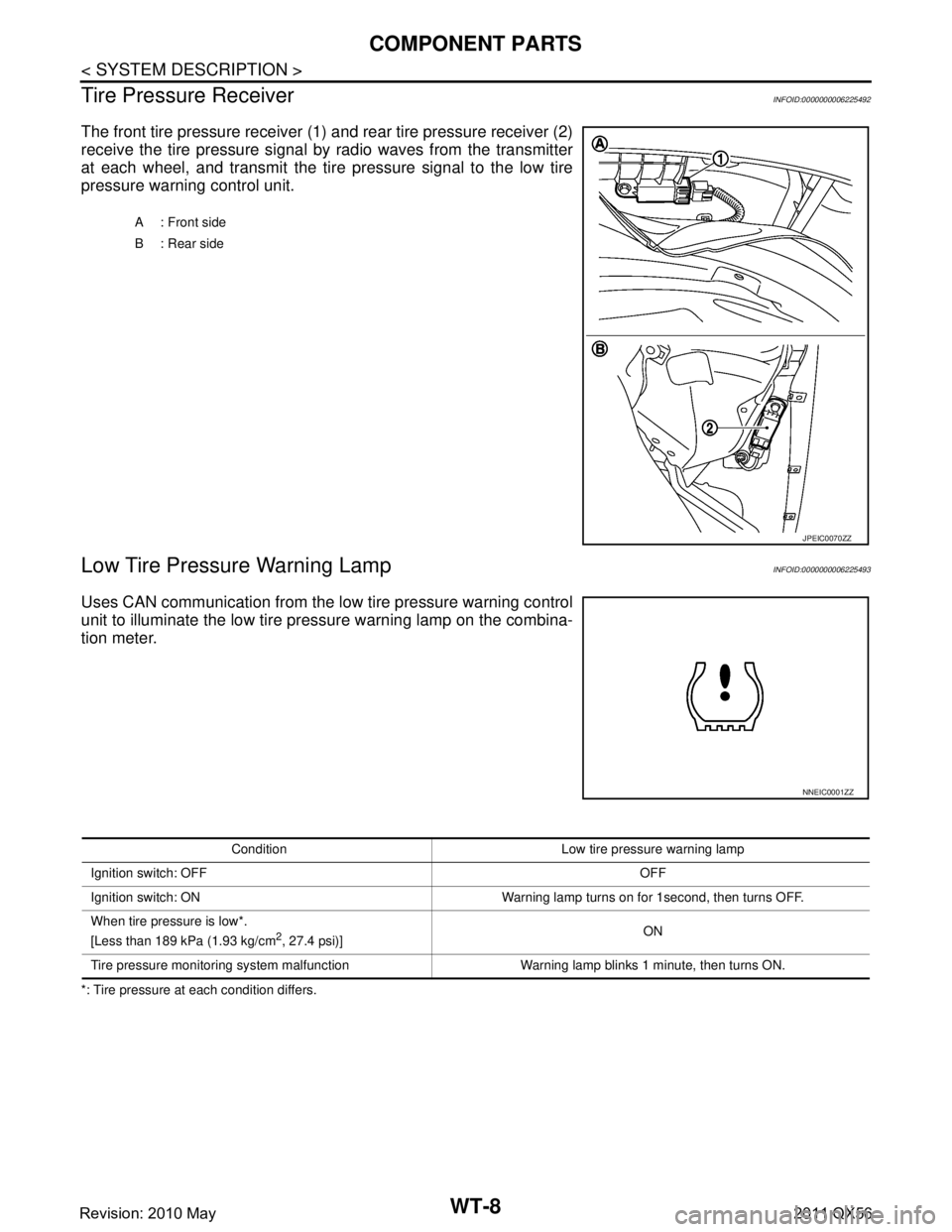
WT-8
< SYSTEM DESCRIPTION >
COMPONENT PARTS
Tire Pressure Receiver
INFOID:0000000006225492
The front tire pressure receiver (1) and rear tire pressure receiver (2)
receive the tire pressure signal by radio waves from the transmitter
at each wheel, and transmit the tire pressure signal to the low tire
pressure warning control unit.
Low Tire Pressure Warning LampINFOID:0000000006225493
Uses CAN communication from the low tire pressure warning control
unit to illuminate the low tire pressure warning lamp on the combina-
tion meter.
*: Tire pressure at each condition differs. A: Front side
B : Rear side
JPEIC0070ZZ
NNEIC0001ZZ
Condition Low tire pr
essure warning lamp
Ignition switch: OFF OFF
Ignition switch: ON Warning lamp turns on for 1second, then turns OFF.
When tire pressure is low*.
[Less than 189 kPa (1.93 kg/cm
2, 27.4 psi)] ON
Tire pressure monitoring system malfunction Warning lamp blinks 1 minute, then turns ON.
Revision: 2010 May2011 QX56
Page 5459 of 5598
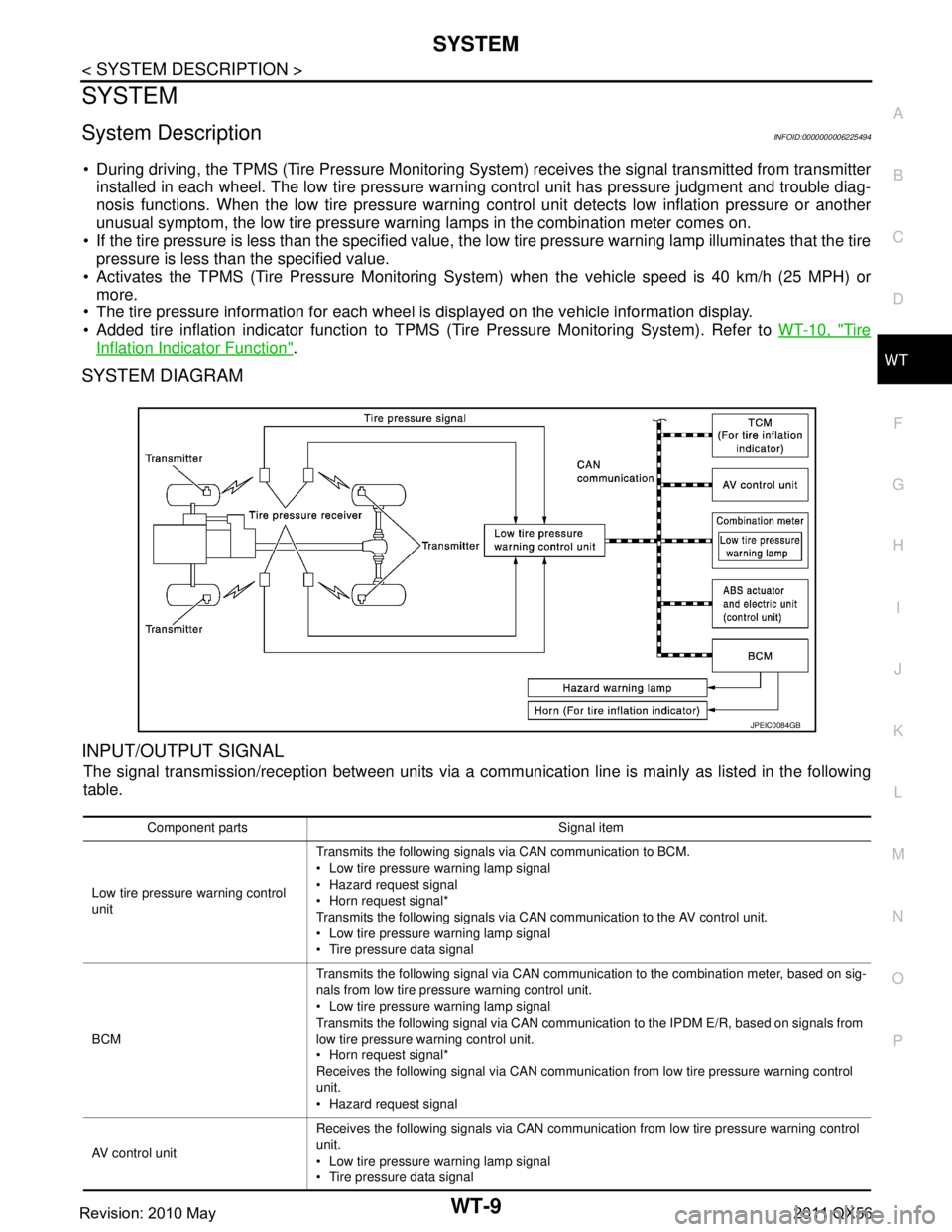
SYSTEMWT-9
< SYSTEM DESCRIPTION >
C
DF
G H
I
J
K L
M A
B
WT
N
O P
SYSTEM
System DescriptionINFOID:0000000006225494
During driving, the TPMS (Tire Pressure Monitoring System) receives the signal transmitted from transmitter
installed in each wheel. The low tire pressure warning control unit has pressure judgment and trouble diag-
nosis functions. When the low tire pressure warning control unit detects low inflation pressure or another
unusual symptom, the low tire pressure warning lamps in the combination meter comes on.
If the tire pressure is less than the specified value, t he low tire pressure warning lamp illuminates that the tire
pressure is less than the specified value.
Activates the TPMS (Tire Pressure Monitoring Sy stem) when the vehicle speed is 40 km/h (25 MPH) or
more.
The tire pressure information for each wheel is displayed on the vehicle information display.
Added tire inflation indicator function to TPMS (Tire Pressure Monitoring System). Refer to WT-10, "
Tire
Inflation Indicator Function".
SYSTEM DIAGRAM
INPUT/OUTPUT SIGNAL
The signal transmission/reception between units via a comm unication line is mainly as listed in the following
table.
JPEIC0084GB
Component parts Signal item
Low tire pressure warning control
unit Transmits the following signals via CAN communication to BCM.
Low tire pressure
warning lamp signal
Hazard request signal
Horn request signal*
Transmits the following signals via CAN communication to the AV control unit.
Low tire pressure warning lamp signal
Tire pressure data signal
BCM Transmits the following signal via CAN communication to the combination meter, based on sig-
nals from low tire pressure warning control unit.
Low tire pressure
warning lamp signal
Transmits the following signal via CAN communication to the IPDM E/R, based on signals from
low tire pressure wa rning control unit.
Horn request signal*
Receives the following signal via CAN communication from low tire pressure warning control
unit.
Hazard request signal
AV control unit Receives the following signals via CAN communication from low tire pressure warning control
unit.
Low tire pressure
warning lamp signal
Tire pressure data signal
Revision: 2010 May2011 QX56
Page 5460 of 5598
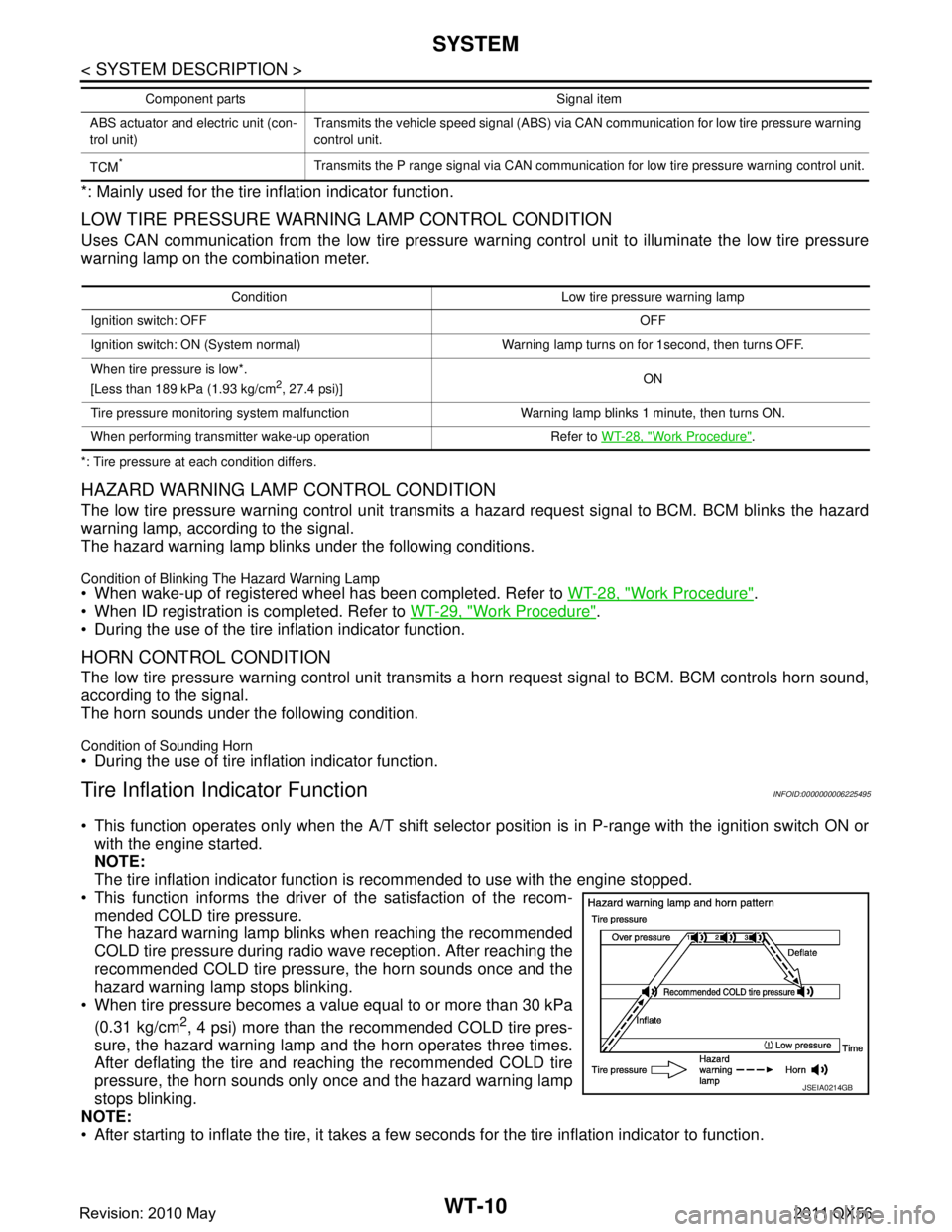
WT-10
< SYSTEM DESCRIPTION >
SYSTEM
*: Mainly used for the tire inflation indicator function.
LOW TIRE PRESSURE WARNING LAMP CONTROL CONDITION
Uses CAN communication from the low tire pressure warning control unit to illuminate the low tire pressure
warning lamp on the combination meter.
*: Tire pressure at each condition differs.
HAZARD WARNING LAMP CONTROL CONDITION
The low tire pressure warning control unit transmits a hazard request signal to BCM. BCM blinks the hazard
warning lamp, according to the signal.
The hazard warning lamp blinks under the following conditions.
Condition of Blinking The Hazard Warning Lamp When wake-up of registered wheel has been completed. Refer to WT-28, "Work Procedure".
When ID registration is completed. Refer to WT-29, "
Work Procedure".
During the use of the tire inflation indicator function.
HORN CONTROL CONDITION
The low tire pressure warning control unit transmits a horn request signal to BCM. BCM controls horn sound,
according to the signal.
The horn sounds under the following condition.
Condition of Sounding Horn During the use of tire inflation indicator function.
Tire Inflation Indicator FunctionINFOID:0000000006225495
This function operates only when the A/T shift selector position is in P-range with the ignition switch ON or
with the engine started.
NOTE:
The tire inflation indicator function is recommended to use with the engine stopped.
This function informs the driver of the satisfaction of the recom- mended COLD tire pressure.
The hazard warning lamp blinks when reaching the recommended
COLD tire pressure during radio wave reception. After reaching the
recommended COLD tire pressure, the horn sounds once and the
hazard warning lamp stops blinking.
When tire pressure becomes a value equal to or more than 30 kPa
(0.31 kg/cm
2, 4 psi) more than the recommended COLD tire pres-
sure, the hazard warning lamp and the horn operates three times.
After deflating the tire and reaching the recommended COLD tire
pressure, the horn sounds only once and the hazard warning lamp
stops blinking.
NOTE:
After starting to inflate the tire, it takes a few seconds for the tire inflation indicator to function.
ABS actuator and electric unit (con-
trol unit) Transmits the vehicle speed signal (ABS) via CAN communication for low tire pressure warning
control unit.
TCM
*Transmits the P range signal via CAN communication for low tire pressure warning control unit.
Component parts Signal item
Condition Low tire pr
essure warning lamp
Ignition switch: OFF OFF
Ignition switch: ON (System normal) Warning lamp turns on for 1second, then turns OFF.
When tire pressure is low*.
[Less than 189 kPa (1.93 kg/cm
2, 27.4 psi)] ON
Tire pressure monitoring system malfunction Warning lamp blinks 1 minute, then turns ON.
When performing transmitter wake-up operation Refer to WT-28, "
Work Procedure".
JSEIA0214GB
Revision: 2010 May2011 QX56
Page 5475 of 5598
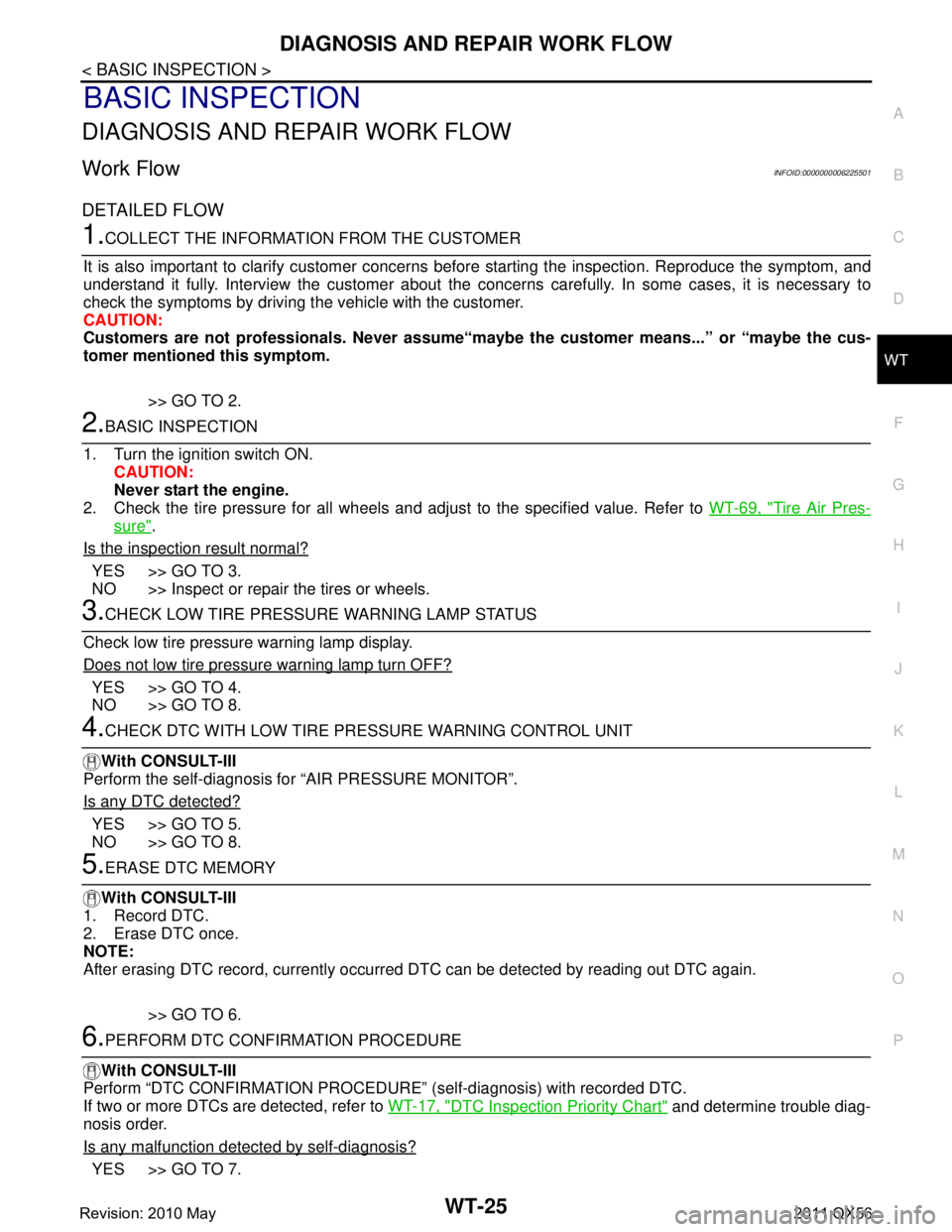
DIAGNOSIS AND REPAIR WORK FLOWWT-25
< BASIC INSPECTION >
C
DF
G H
I
J
K L
M A
B
WT
N
O P
BASIC INSPECTION
DIAGNOSIS AND REPAIR WORK FLOW
Work Flow INFOID:0000000006225501
DETAILED FLOW
1.COLLECT THE INFORMATION FROM THE CUSTOMER
It is also important to clarify customer concerns before starting the inspection. Reproduce the symptom, and
understand it fully. Interview the customer about the concer ns carefully. In some cases, it is necessary to
check the symptoms by driving the vehicle with the customer.
CAUTION:
Customers are not professionals. Never assume“mayb e the customer means...” or “maybe the cus-
tomer mentioned this symptom.
>> GO TO 2.
2.BASIC INSPECTION
1. Turn the ignition switch ON. CAUTION:
Never start the engine.
2. Check the tire pressure for all wheels and adjust to the specified value. Refer to WT-69, "
Tire Air Pres-
sure".
Is the inspection result normal?
YES >> GO TO 3.
NO >> Inspect or repair the tires or wheels.
3.CHECK LOW TIRE PRESSURE WARNING LAMP STATUS
Check low tire pressure warning lamp display.
Does not low tire pressure warning lamp turn OFF?
YES >> GO TO 4.
NO >> GO TO 8.
4.CHECK DTC WITH LOW TIRE PR ESSURE WARNING CONTROL UNIT
With CONSULT-III
Perform the self-diagnosis fo r “AIR PRESSURE MONITOR”.
Is any DTC detected?
YES >> GO TO 5.
NO >> GO TO 8.
5.ERASE DTC MEMORY
With CONSULT-III
1. Record DTC.
2. Erase DTC once.
NOTE:
After erasing DTC record, currently occurr ed DTC can be detected by reading out DTC again.
>> GO TO 6.
6.PERFORM DTC CONFIRMATION PROCEDURE
With CONSULT-III
Perform “DTC CONFIRMATION PROCEDURE” (self-diagnosis) with recorded DTC.
If two or more DTCs are detected, refer to WT-17, "
DTC Inspection Priority Chart" and determine trouble diag-
nosis order.
Is any malfunction detected by self-diagnosis?
YES >> GO TO 7.
Revision: 2010 May2011 QX56
Page 5478 of 5598

WT-28
< BASIC INSPECTION >
TRANSMITTER WAKE UP OPERATION
TRANSMITTER WAKE UP OPERATION
DescriptionINFOID:0000000006225504
When replacing transmitter, always transmitter wake-up is required.
Work ProcedureINFOID:0000000006225505
1.TRANSMITTER WAKE-UP PROCEDURE
1. Turn the ignition switch ON.
2. Press the transmitter activation tool (J-45295) (1) against the side of the tire at the location closest to the transmitter.
3. Wait until the indicator lamp turns OFF (approximately 5 sec- onds).
CAUTION:
Perform the wake-up procedure starting from the vehicle
front left wheel, then repeat the procedure in the order of
the front right wheel, rear right wheel, and rear left wheel.
4. Check that the low tire pressure warning lamp blinks in the pattern shown as per the following. The pattern
indicates that the transmitter wake- up procedure for the wheel is completed.
5. Check that the hazard warning lamp blink twice w hen the transmitter wake-up procedure for all wheels is
completed.
6. Check that the low tire pressure warning lamp turn s OFF, after the transmitter wake-up procedure is com-
pleted for all wheels and turns OFF.
Is the transmitter wake-up completed?
YES >> Perform the transmitter ID registration procedure. Refer to WT-29, "Work Procedure".
NO >> Perform trouble diagnosis for the transmitter. Refer to WT-33, "
Diagnosis Procedure".
NNEIC0020ZZ
JPEIC0089GB
Revision: 2010 May2011 QX56
Page 5479 of 5598
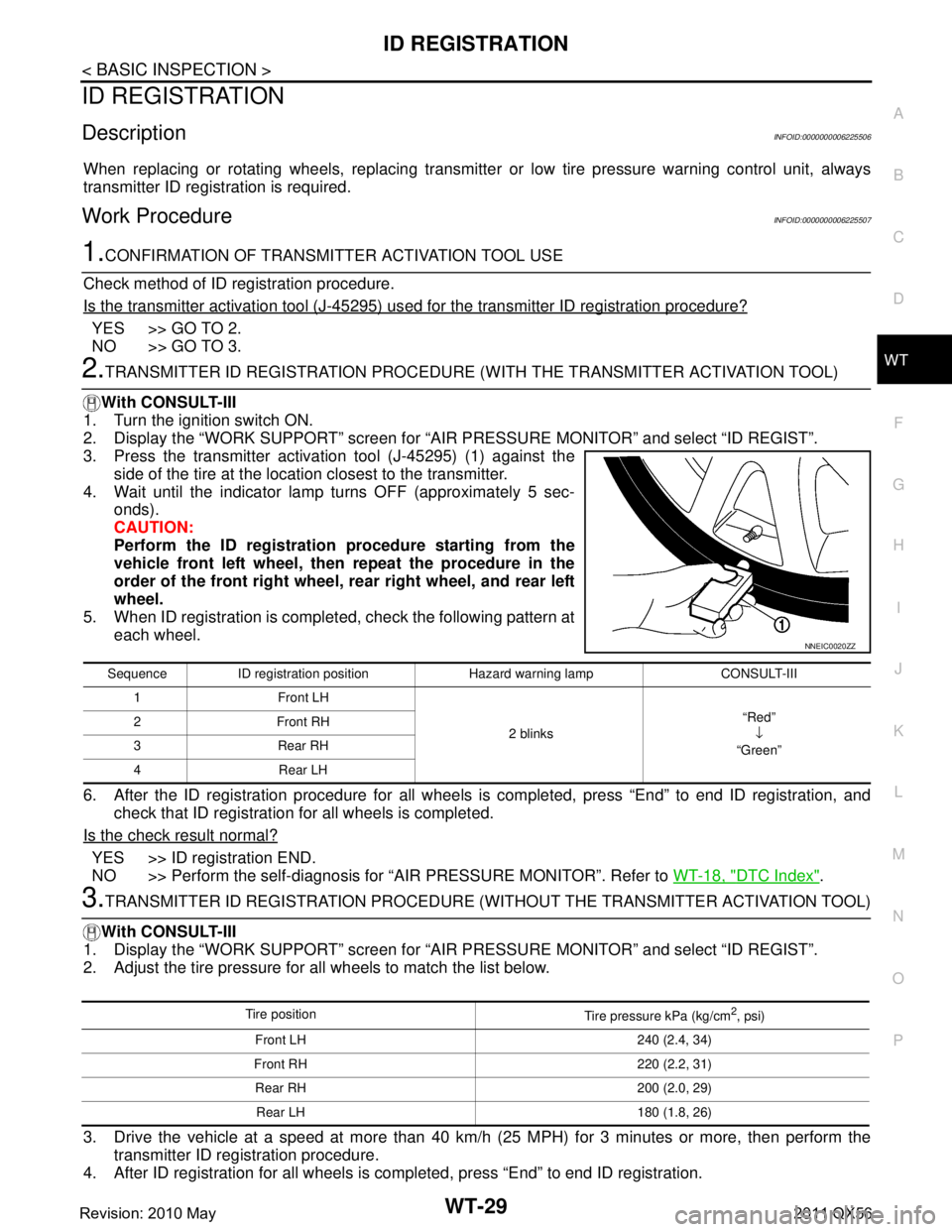
ID REGISTRATIONWT-29
< BASIC INSPECTION >
C
DF
G H
I
J
K L
M A
B
WT
N
O P
ID REGISTRATION
DescriptionINFOID:0000000006225506
When replacing or rotating wheels, replacing transmitter or low tire pressure warning control unit, always
transmitter ID registration is required.
Work ProcedureINFOID:0000000006225507
1.CONFIRMATION OF TRANSMITTER ACTIVATION TOOL USE
Check method of ID registration procedure.
Is the transmitter activation tool (J-45295) us ed for the transmitter ID registration procedure?
YES >> GO TO 2.
NO >> GO TO 3.
2.TRANSMITTER ID REGISTRATION PROCEDURE (W ITH THE TRANSMITTER ACTIVATION TOOL)
With CONSULT-III
1. Turn the ignition switch ON.
2. Display the “WORK SUPPORT” screen for “AIR PRESSURE MONITOR” and select “ID REGIST”.
3. Press the transmitter activation tool (J-45295) (1) against the
side of the tire at the location closest to the transmitter.
4. Wait until the indicator lamp turns OFF (approximately 5 sec- onds).
CAUTION:
Perform the ID registration procedure starting from the
vehicle front left wheel, then repeat the procedure in the
order of the front right wheel, rear right wheel, and rear left
wheel.
5. When ID registration is completed, check the following pattern at
each wheel.
6. After the ID registration procedure for all wheels is completed, press “End” to end ID registration, and
check that ID registration for all wheels is completed.
Is the check result normal?
YES >> ID registration END.
NO >> Perform the self-diagnosis for “AIR PRESSURE MONITOR”. Refer to WT-18, "
DTC Index".
3.TRANSMITTER ID REGISTRATION PROCEDURE (WITHOUT THE TRANSMITTER ACTIVATION TOOL)
With CONSULT-III
1. Display the “WORK SUPPORT” screen for “AIR PRESSURE MONITOR” and select “ID REGIST”.
2. Adjust the tire pressure for all wheels to match the list below.
3. Drive the vehicle at a speed at more than 40 km/h (25 MPH) for 3 minutes or more, then perform the
transmitter ID registration procedure.
4. After ID registration for all wheels is completed, press “End” to end ID registration.
Sequence ID registration position Hazard warning lamp CONSULT-III
1 Front LH
2 blinks“Red”
↓
“Green”
2Front RH
3Rear RH
4 Rear LH
NNEIC0020ZZ
Tire position
Tire pressure kPa (kg/cm2, psi)
Front LH 240 (2.4, 34)
Front RH 220 (2.2, 31) Rear RH 200 (2.0, 29)Rear LH 180 (1.8, 26)
Revision: 2010 May2011 QX56
Page 5480 of 5598

WT-30
< BASIC INSPECTION >
ID REGISTRATION
5. Adjust the tire pressures for all wheels to the specified value. Refer to WT-69, "Tire Air Pressure".
Is ID registrations for all wheels completed?
YES >> ID registration END.
NO >> Perform the self-diagnosis for “AIR PRESSURE MONITOR”. Refer to WT-18, "
DTC Index".
ID registration position CONSULT-III
Front LH “Red”↓
“Green”
Front RH
Rear RHRear LH
Revision: 2010 May2011 QX56
Page 5481 of 5598
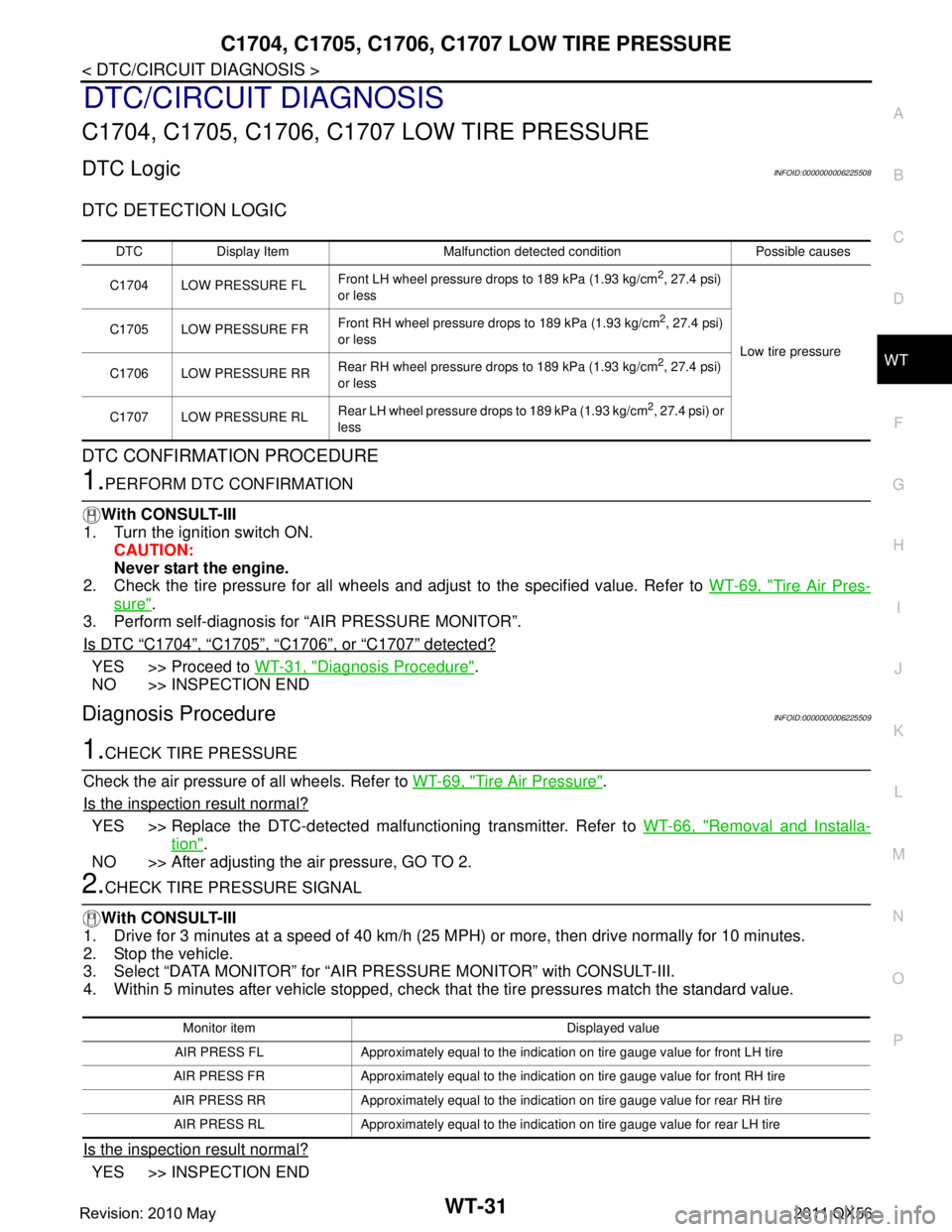
C1704, C1705, C1706, C1707 LOW TIRE PRESSURE
WT-31
< DTC/CIRCUIT DIAGNOSIS >
C
D F
G H
I
J
K L
M A
B
WT
N
O P
DTC/CIRCUIT DIAGNOSIS
C1704, C1705, C1706, C1707 LOW TIRE PRESSURE
DTC LogicINFOID:0000000006225508
DTC DETECTION LOGIC
DTC CONFIRMATION PROCEDURE
1.PERFORM DTC CONFIRMATION
With CONSULT-III
1. Turn the ignition switch ON.
CAUTION:
Never start the engine.
2. Check the tire pressure for all wheels and adjust to the specified value. Refer to WT-69, "
Tire Air Pres-
sure".
3. Perform self-diagnosis for “AIR PRESSURE MONITOR”.
Is DTC
“C1704”, “C1705”, “C1706”, or “C1707” detected?
YES >> Proceed to WT-31, "Diagnosis Procedure".
NO >> INSPECTION END
Diagnosis ProcedureINFOID:0000000006225509
1.CHECK TIRE PRESSURE
Check the air pressure of all wheels. Refer to WT-69, "
Tire Air Pressure".
Is the inspection result normal?
YES >> Replace the DTC-detected malfunctioning transmitter. Refer to WT-66, "Removal and Installa-
tion".
NO >> After adjusting the air pressure, GO TO 2.
2.CHECK TIRE PRESSURE SIGNAL
With CONSULT-III
1. Drive for 3 minutes at a speed of 40 km/h (25 MPH) or more, then drive normally for 10 minutes.
2. Stop the vehicle.
3. Select “DATA MONITOR” for “AIR PRESSURE MONITOR” with CONSULT-III.
4. Within 5 minutes after vehicle stopped, check t hat the tire pressures match the standard value.
Is the inspection result normal?
YES >> INSPECTION END
DTC Display Item Malfunction detected condition Possible causes
C1704 LOW PRESSURE FL Front LH wheel pressure drops to 189 kPa (1.93 kg/cm
2, 27.4 psi)
or less
Low tire pressure
C1705 LOW PRESSURE FR
Front RH wheel pressure drops to 189 kPa (1.93 kg/cm
2, 27.4 psi)
or less
C1706 LOW PRESSURE RR Rear RH wheel pressure drops to 189 kPa (1.93 kg/cm
2, 27.4 psi)
or less
C1707 LOW PRESSURE RL Rear LH wheel pressure drops to 189 kPa (1.93 kg/cm
2, 27.4 psi) or
less
Monitor item Displayed value
AIR PRESS FL Approximately equal to the indication on tire gauge value for front LH tire
AIR PRESS FR Approximately equal to the indication on tire gauge value for front RH tire
AIR PRESS RR Approximately equal to the indica tion on tire gauge value for rear RH tire
AIR PRESS RL Approximately equal to the indication on tire gauge value for rear LH tire
Revision: 2010 May2011 QX56